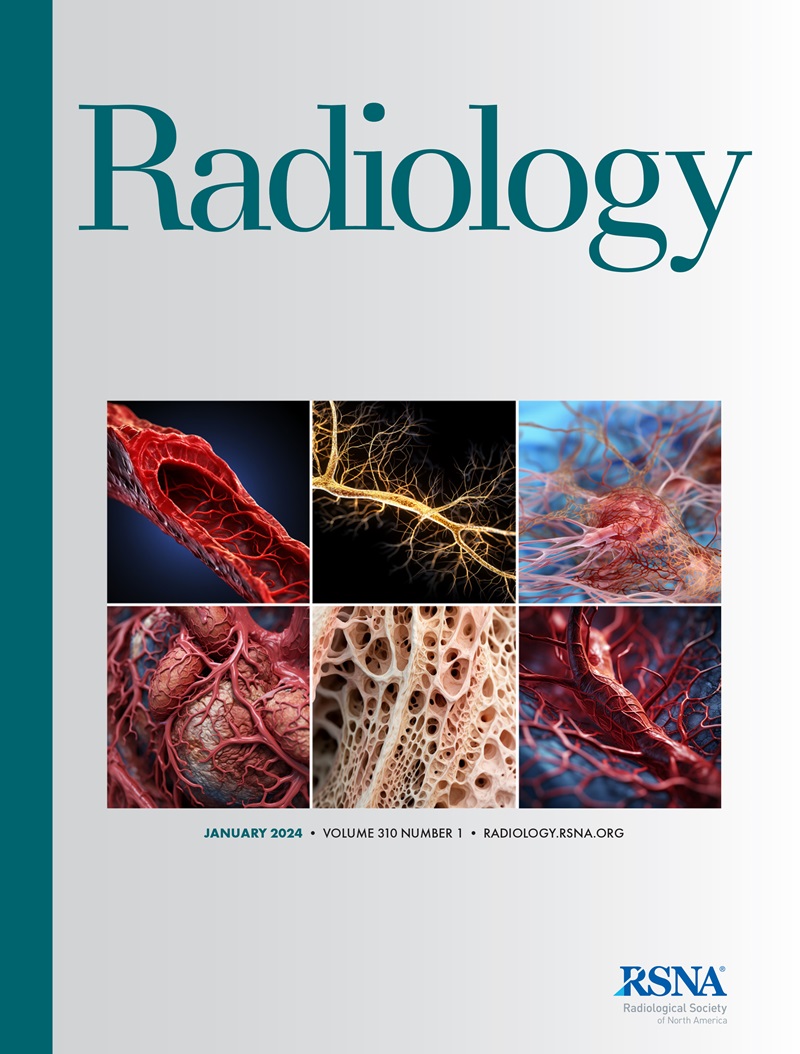Yan Zhuang, Tejas Sudharshan Mathai, Pritam Mukherjee, Brandon Khoury, Boah Kim, Benjamin Hou, Nusrat Rabbee, Abhinav Suri, Ronald M Summers
求助PDF
{"title":"mrissegmenter:一个完全准确和强大的自动化多器官和结构分割工具,用于t1加权腹部MRI。","authors":"Yan Zhuang, Tejas Sudharshan Mathai, Pritam Mukherjee, Brandon Khoury, Boah Kim, Benjamin Hou, Nusrat Rabbee, Abhinav Suri, Ronald M Summers","doi":"10.1148/radiol.241979","DOIUrl":null,"url":null,"abstract":"<p><p>Background There is a pressing demand to develop an automated segmentation tool for abdominal MRI that can provide accurate and robust segmentation in more than 60 abdominal organs and structures. Purpose To develop and evaluate the accuracy and robustness of an automated multiorgan and structure segmentation tool for T1-weighted abdominal MRI. Materials and Methods In this retrospective study, a T1-weighted abdominal MRI dataset composed of axial precontrast T1-weighted and contrast-enhanced T1-weighted arterial, portal venous, and delayed phases for each patient in a randomly selected sample was included at the National Institutes of Health Clinical Center. Each MRI series contained voxel-level annotations of 62 abdominal organs and structures. A three-dimensional segmentation (nnU-Net) model, called MRISegmenter, was trained on this dataset. This internal dataset was then randomly split into training and internal test sets. Evaluation was conducted on the internal test set and two external test sets (Abdominal Multi-Organ Segmentation Challenge 2022 [AMOS22] and Duke Liver). The predicted segmentations were compared against the radiologist-verified reference standard annotations using means ± SDs for the Dice similarity coefficient (Dice score) and normalized surface distance (NSD). The segmentation tool and dataset are publicly available at <i>https://github.com/rsummers11/MRISegmenter</i>. Results A total of 195 patients (training set, 135 patients [mean age, 54.7 years ± 16.3 {SD}; 72 male patients, 63 female patients]; internal test set, 60 patients [mean age, 51.1 years ± 14.4; 26 male patients, 34 female patients]) with 780 MRI scans containing 62 annotations each were included. On the internal test set, MRISegmenter achieved a mean Dice score of 0.861 ± 0.118 and a mean NSD of 0.924 ± 0.073. On external test sets AMOS22 (60 MRI scans) and Duke Liver (95 patients; 172 MRI scans), MRISegmenter attained a mean Dice score of 0.829 ± 0.133 and a mean NSD of 0.908 ± 0.067 and a mean Dice score of 0.933 ± 0.015 and a mean NSD of 0.929 ± 0.021, respectively. Conclusion MRISegmenter provided accurate and robust segmentation of 62 organs and structures at T1-weighted abdominal MRI. © RSNA, 2025 <i>Supplemental material is available for this article.</i> See also the editorial by Murphy in this issue.</p>","PeriodicalId":20896,"journal":{"name":"Radiology","volume":"315 1","pages":"e241979"},"PeriodicalIF":15.2000,"publicationDate":"2025-04-01","publicationTypes":"Journal Article","fieldsOfStudy":null,"isOpenAccess":false,"openAccessPdf":"","citationCount":"0","resultStr":"{\"title\":\"MRISegmenter: A Fully Accurate and Robust Automated Multiorgan and Structure Segmentation Tool for T1-weighted Abdominal MRI.\",\"authors\":\"Yan Zhuang, Tejas Sudharshan Mathai, Pritam Mukherjee, Brandon Khoury, Boah Kim, Benjamin Hou, Nusrat Rabbee, Abhinav Suri, Ronald M Summers\",\"doi\":\"10.1148/radiol.241979\",\"DOIUrl\":null,\"url\":null,\"abstract\":\"<p><p>Background There is a pressing demand to develop an automated segmentation tool for abdominal MRI that can provide accurate and robust segmentation in more than 60 abdominal organs and structures. Purpose To develop and evaluate the accuracy and robustness of an automated multiorgan and structure segmentation tool for T1-weighted abdominal MRI. Materials and Methods In this retrospective study, a T1-weighted abdominal MRI dataset composed of axial precontrast T1-weighted and contrast-enhanced T1-weighted arterial, portal venous, and delayed phases for each patient in a randomly selected sample was included at the National Institutes of Health Clinical Center. Each MRI series contained voxel-level annotations of 62 abdominal organs and structures. A three-dimensional segmentation (nnU-Net) model, called MRISegmenter, was trained on this dataset. This internal dataset was then randomly split into training and internal test sets. Evaluation was conducted on the internal test set and two external test sets (Abdominal Multi-Organ Segmentation Challenge 2022 [AMOS22] and Duke Liver). The predicted segmentations were compared against the radiologist-verified reference standard annotations using means ± SDs for the Dice similarity coefficient (Dice score) and normalized surface distance (NSD). The segmentation tool and dataset are publicly available at <i>https://github.com/rsummers11/MRISegmenter</i>. Results A total of 195 patients (training set, 135 patients [mean age, 54.7 years ± 16.3 {SD}; 72 male patients, 63 female patients]; internal test set, 60 patients [mean age, 51.1 years ± 14.4; 26 male patients, 34 female patients]) with 780 MRI scans containing 62 annotations each were included. On the internal test set, MRISegmenter achieved a mean Dice score of 0.861 ± 0.118 and a mean NSD of 0.924 ± 0.073. On external test sets AMOS22 (60 MRI scans) and Duke Liver (95 patients; 172 MRI scans), MRISegmenter attained a mean Dice score of 0.829 ± 0.133 and a mean NSD of 0.908 ± 0.067 and a mean Dice score of 0.933 ± 0.015 and a mean NSD of 0.929 ± 0.021, respectively. Conclusion MRISegmenter provided accurate and robust segmentation of 62 organs and structures at T1-weighted abdominal MRI. © RSNA, 2025 <i>Supplemental material is available for this article.</i> See also the editorial by Murphy in this issue.</p>\",\"PeriodicalId\":20896,\"journal\":{\"name\":\"Radiology\",\"volume\":\"315 1\",\"pages\":\"e241979\"},\"PeriodicalIF\":15.2000,\"publicationDate\":\"2025-04-01\",\"publicationTypes\":\"Journal Article\",\"fieldsOfStudy\":null,\"isOpenAccess\":false,\"openAccessPdf\":\"\",\"citationCount\":\"0\",\"resultStr\":null,\"platform\":\"Semanticscholar\",\"paperid\":null,\"PeriodicalName\":\"Radiology\",\"FirstCategoryId\":\"3\",\"ListUrlMain\":\"https://doi.org/10.1148/radiol.241979\",\"RegionNum\":1,\"RegionCategory\":\"医学\",\"ArticlePicture\":[],\"TitleCN\":null,\"AbstractTextCN\":null,\"PMCID\":null,\"EPubDate\":\"\",\"PubModel\":\"\",\"JCR\":\"Q1\",\"JCRName\":\"RADIOLOGY, NUCLEAR MEDICINE & MEDICAL IMAGING\",\"Score\":null,\"Total\":0}","platform":"Semanticscholar","paperid":null,"PeriodicalName":"Radiology","FirstCategoryId":"3","ListUrlMain":"https://doi.org/10.1148/radiol.241979","RegionNum":1,"RegionCategory":"医学","ArticlePicture":[],"TitleCN":null,"AbstractTextCN":null,"PMCID":null,"EPubDate":"","PubModel":"","JCR":"Q1","JCRName":"RADIOLOGY, NUCLEAR MEDICINE & MEDICAL IMAGING","Score":null,"Total":0}
引用次数: 0
引用
批量引用

 求助内容:
求助内容: 应助结果提醒方式:
应助结果提醒方式:


